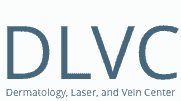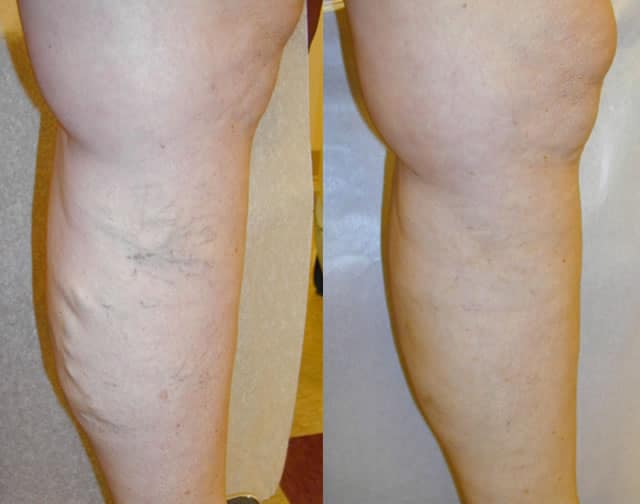Venefit™ Targeted Endovenous Therapy is the only minimally invasive procedure to use segmental radiofrequency (RF) energy to provide an even and uniform heat to contract the collagen in the vein walls, causing them to collapse and seal the vein closed. Blood is then re-routed through healthy veins back towards the heart.
The Venefit™ procedure involves inserting the Covidien ClosureFast™ Endovenous Radiofrequency Ablation (RFA) Catheter into the diseased vein through a small incision below the knee and threading the catheter through the vessel. In contrast to laser therapy, the ClosureFast™ catheter eliminates the need for continuous pull-back of the energy source, allowing for more controlled and repeatable radiofrequency ablation to 7 cm segments of the target vessel at a time. Blood flow is then naturally redirected to healthy veins as the recovery process begins. The treated vein becomes scar tissue and is eventually absorbed by the body.
The Venefit procedure uses a segmental ablation technique, which incorporates the ClosureFast catheter to heat a 7 cm vein length in one 20-second interval. After each segment is treated, the catheter is re-positioned to the next segment, and the process is repeated until the entire length of the diseased vein has been sealed. The catheter delivers uniform, consistent heat to each segment. Shorter refluxing vein lengths can also be treated using the Covidien ClosureFast™ 3 cm Endovenous Radiofrequency Ablation (RFA) Catheter, which heats vein segments in 3 cm lengths. Incompetent perforator veins and tributary veins, a potential cause of bulging varicosities and leg ulcers, can be treated using a specialized ClosureRFS™ stylet.
Frequently Asked Questions:
The Venefit™ procedure is a minimally invasive treatment option that uses radiofrequency (RF) energy to effectively treat patients suffering from varicose veins or chronic venous insufficiency (CVI). A vein specialist inserts the ClosureFast™ catheter into the diseased vein to provide consistent and uniform heat to contract the collagen in the vein walls, causing them to shrink and seal closed. Once the diseased vein is closed, blood will re-route itself to other healthy veins.
The Venefit™ procedure is just a new name for the VNUS Closure procedure, providing the same clinically proven results with the same great patient recovery profile.
During vein stripping, incisions are made in the groin and calf, and a tool is threaded through the diseased vein to pull the vein out of the leg. With the Venefit™ procedure, only one small incision is made at the insertion site and the vein is then treated and left in place. This minimally invasive approach reduces the likelihood of pain and bruising.
Although the Venefit™ procedure and endovenous laser ablation are both minimally invasive procedures, a comparative, multi-center study showed that the Venefit™ procedure was associated with statistically significant lower rates of pain, bruising and complications. Patients undergoing the Venefit™ procedure also reported improvements in quality of life measures up to four times faster than patients treated with endovenous laser ablation (the study was conducted with a 980nm laser).
The Venefit™ procedure takes approximately 45-60 minutes, although patients may normally spend 2-3 hours at the medical facility due to normal pre- and post-treatment procedures.
Most patients report feeling little, if any, pain during the Venefit™ procedure.3 Your physician should give you a local or regional anesthetic to numb the treatment area.
The Venefit™ procedure is usually performed under local or regional anesthesia. It is generally performed in a vein specialist's office or an outpatient surgical facility.
Patients treated with the Venefit™ procedure may resume normal activities more quickly than patients who undergo surgical vein stripping or endovenous laser ablation. With the Venefit™ procedure, the average patient typically resumes normal activities within a few days.
For a few weeks following the treatment, your physician may recommend a regular walking regimen and suggest you refrain from very strenuous activities (heavy lifting, for example) or prolonged periods of standing.
Most patients report a noticeable improvement in their symptoms within 1-2 weeks following the procedure.
Patients report limited to no scarring, bruising or swelling following the Venefit™ procedure using the ClosureFast™ catheter.
As with all medical procedures, potential risks and complications exist including vessel perforation (when the catheter punctures the vein wall), thrombosis, pulmonary embolism (when a blood clot travels to the lungs), phlebitis (inflammation of the vein), infection, nerve damage, arteriovenous fistula (an abnormal connection between an artery and a vein), hematoma (bruising), and skin burn. As with all medical procedures, consult your physician to understand the risks and benefits of the procedure.
Only a vein specialist can tell you if the Venefit™ procedure is the right option for your vein problem. Experience has shown that many patients with varicose veins or CVI can be treated with the Venefit™ procedure.
The most important step in determining whether or not the Venefit™ procedure is appropriate for you is a complete ultrasound examination by your vein specialist. Age alone is not a factor in determining whether or not the Venefit™ procedure is appropriate for you. The Venefit™ procedure has been used to treat both women and men across a wide range of ages.
The Venefit™ procedure has been shown in a large international, multi-center study to be 93% effective over three years.
Many insurance companies pay for the Venefit™ procedure in part or in full. The Venefit™ procedure has coverage policies with major health insurers. Please discuss your coverage with your insurance provider prior to seeking treatment.
Courtesy of venefitprocedure.com
Sclerotherapy
Sclerotherapy is the standard treatment for varicose and spider veins. A special sclerosing solution is injected into the diseased vein, which then collapses and is gradually absorbed by the body. By the end of the treatment program, the veins are less visible on the skin surface. Sclerotherapy usually also relieves symptoms associated with enlarged veins and prevents further complications.
Click on photo to view full size
*Actual patient. Individual results may vary.
View more Before and After Photos
Back to Top



